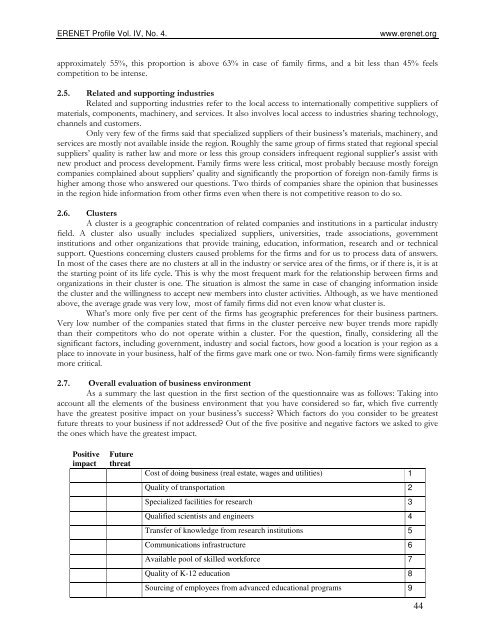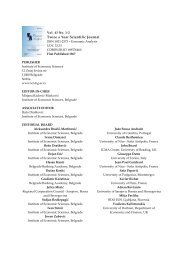Issue 16
Issue 16
Issue 16
You also want an ePaper? Increase the reach of your titles
YUMPU automatically turns print PDFs into web optimized ePapers that Google loves.
ERENET Profile Vol. IV, No. 4.<br />
www.erenet.org<br />
approximately 55%, this proportion is above 63% in case of family firms, and a bit less than 45% feels<br />
competition to be intense.<br />
2.5. Related and supporting industries<br />
Related and supporting industries refer to the local access to internationally competitive suppliers of<br />
materials, components, machinery, and services. It also involves local access to industries sharing technology,<br />
channels and customers.<br />
Only very few of the firms said that specialized suppliers of their business’s materials, machinery, and<br />
services are mostly not available inside the region. Roughly the same group of firms stated that regional special<br />
suppliers’ quality is rather law and more or less this group considers infrequent regional supplier’s assist with<br />
new product and process development. Family firms were less critical, most probably because mostly foreign<br />
companies complained about suppliers’ quality and significantly the proportion of foreign non-family firms is<br />
higher among those who answered our questions. Two thirds of companies share the opinion that businesses<br />
in the region hide information from other firms even when there is not competitive reason to do so.<br />
2.6. Clusters<br />
A cluster is a geographic concentration of related companies and institutions in a particular industry<br />
field. A cluster also usually includes specialized suppliers, universities, trade associations, government<br />
institutions and other organizations that provide training, education, information, research and or technical<br />
support. Questions concerning clusters caused problems for the firms and for us to process data of answers.<br />
In most of the cases there are no clusters at all in the industry or service area of the firms, or if there is, it is at<br />
the starting point of its life cycle. This is why the most frequent mark for the relationship between firms and<br />
organizations in their cluster is one. The situation is almost the same in case of changing information inside<br />
the cluster and the willingness to accept new members into cluster activities. Although, as we have mentioned<br />
above, the average grade was very low, most of family firms did not even know what cluster is.<br />
What’s more only five per cent of the firms has geographic preferences for their business partners.<br />
Very low number of the companies stated that firms in the cluster perceive new buyer trends more rapidly<br />
than their competitors who do not operate within a cluster. For the question, finally, considering all the<br />
significant factors, including government, industry and social factors, how good a location is your region as a<br />
place to innovate in your business, half of the firms gave mark one or two. Non-family firms were significantly<br />
more critical.<br />
2.7. Overall evaluation of business environment<br />
As a summary the last question in the first section of the questionnaire was as follows: Taking into<br />
account all the elements of the business environment that you have considered so far, which five currently<br />
have the greatest positive impact on your business’s success? Which factors do you consider to be greatest<br />
future threats to your business if not addressed? Out of the five positive and negative factors we asked to give<br />
the ones which have the greatest impact.<br />
Positive<br />
impact<br />
Future<br />
threat<br />
Cost of doing business (real estate, wages and utilities) 1<br />
Quality of transportation 2<br />
Specialized facilities for research 3<br />
Qualified scientists and engineers 4<br />
Transfer of knowledge from research institutions 5<br />
Communications infrastructure 6<br />
Available pool of skilled workforce 7<br />
Quality of K-12 education 8<br />
Sourcing of employees from advanced educational programs 9<br />
44
















